We decided that while we are in North Holland it would be a great opportunity to visit Berlin. We’ve heard that Berlin has some interesting things happening and we decided to see for ourselves.
We used our Trainline app to buy two return tickets to Berlin leaving Amsterdam at 7.00am on a Wednesday morning. This meant that we had to be up and get ourselves to Hoorn station to catch the 6.10am train.
 Using our traditional black ‘Dutch bike,’ a Cortina with front carry rack, we were able to pedal to Hoorn station with about 20 kg of luggage in one big spinner suitcase on the front rack and a few bits and pieces in a backpack.
Using our traditional black ‘Dutch bike,’ a Cortina with front carry rack, we were able to pedal to Hoorn station with about 20 kg of luggage in one big spinner suitcase on the front rack and a few bits and pieces in a backpack.
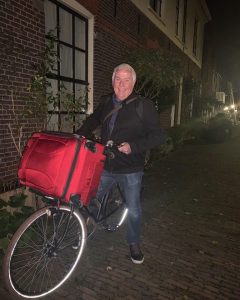
With not many people about at 5.30 or so we easily made the 6.10am train and headed for Amsterdam Centraal and then onto a German train to make the six hour journey East to Berlin. The train crew changed over when we crossed the German border and German police came through the train checking people over; looking to see what type of luggage they were carrying and generally keeping an eye on things.
As we passed two Volkswagen factories we were soon in the former East Germany which totally surrounded the enclave of West Berlin following the carving up of the country and the city at the end of the second world war.
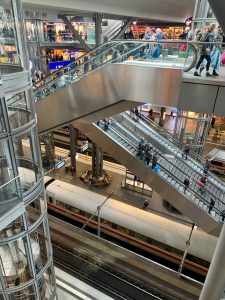 Our train arrived at Berlin Spandau and we needed to change trains for the short remainder of the journey to the Berlin Hauptbahnhof which turned out to be a huge station resembling a large Westfield shopping centre with trainlines running through it at about 3 different levels. It was then just a matter of negotiating a number of escalators to join the Eastbound S Bahn for two stops to Hackerscher Markt, where a colleague of our Berlin home exchange host met us with keys and directions to access our apartment for our stay.
Our train arrived at Berlin Spandau and we needed to change trains for the short remainder of the journey to the Berlin Hauptbahnhof which turned out to be a huge station resembling a large Westfield shopping centre with trainlines running through it at about 3 different levels. It was then just a matter of negotiating a number of escalators to join the Eastbound S Bahn for two stops to Hackerscher Markt, where a colleague of our Berlin home exchange host met us with keys and directions to access our apartment for our stay.
As with most European cities, it’s worth doing a bit of online research before visiting about their public transport ticketing system, what the machines on the station will sell you etc. It’s also worth having a try at a machine where there is not a growing queue of locals in a hurry who get frustrated by your ineptitude at the machine; it lowers the pressure. Look for a little language icon somewhere to select your preferred language. In Berlin, you can buy a 24 hour ticket for 7 Euros usable in zones A and B. This was a great option for us as a single journey ticket costs 2,80 Euro.
As members of a Home Exchange website we have accrued a number of guest points throughout our membership and were able to use some of these to have a non-simultaneous exchange to Berlin, where we ‘pay’ for the nights using points. This turned out to be an excellent way to get a very authentic experience in living in Berlin for a few days. The opportunities to learn more about each other by looking at the way that others organise the same types of things that we all like: frequent public transport, safe fast wifi, shared beliefs about how a fundamentally simple objective can be achieved: just ‘Don’t be a dickhead.”
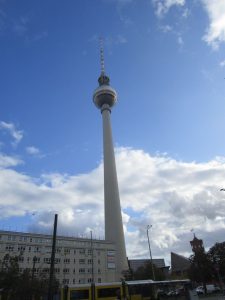 The apartment turned out to be excellent: spacious, clean and well appointed. In addition, it was very near to a range of transport options and bars, restaurants etc. Being just near Alexanderplatz, it also meant that from many places in Berlin we were able to check our bearings by looking for the radio tower high in the sky.
The apartment turned out to be excellent: spacious, clean and well appointed. In addition, it was very near to a range of transport options and bars, restaurants etc. Being just near Alexanderplatz, it also meant that from many places in Berlin we were able to check our bearings by looking for the radio tower high in the sky.
Our first night saw us finding a brewpub nearby for a lovely dinner, where a Danish family told us how an Australian; Mary, had revitalised the Royal house in Denmark; working hard for charities and in service of organisations and adding value to having a royal family.
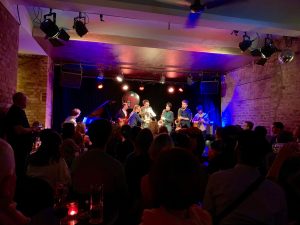 After dinner we headed to a nearby club, the B Flat Acoustic Music and Jazz club which holds a weekly jam session on Wednesday nights. The talent on show was amazing, with excellent soloists across a range of instruments; from double bass to a melodophone; (one of those little piano thingies that they blow into and play). As you can see from the picture, the composition of the band on stage was very fluid, with a variety of musos sitting in on different configurations. You can see from this picture taken by Lynette that there were at least three saxophonists on stage at some stage, and a parade of drummers and bassists, guitarists and keys players; and a strong and acoustically acrobatic female vocal..all excellent. We had a great time being entertained and then had a walk of about 100 metres to get home. One of the great assets of these bars is the table service from really happy and helpful servers. Great music, easy access to great service, cool atmosphere and a vast array of talent on show. A great start to our trip indeed!
After dinner we headed to a nearby club, the B Flat Acoustic Music and Jazz club which holds a weekly jam session on Wednesday nights. The talent on show was amazing, with excellent soloists across a range of instruments; from double bass to a melodophone; (one of those little piano thingies that they blow into and play). As you can see from the picture, the composition of the band on stage was very fluid, with a variety of musos sitting in on different configurations. You can see from this picture taken by Lynette that there were at least three saxophonists on stage at some stage, and a parade of drummers and bassists, guitarists and keys players; and a strong and acoustically acrobatic female vocal..all excellent. We had a great time being entertained and then had a walk of about 100 metres to get home. One of the great assets of these bars is the table service from really happy and helpful servers. Great music, easy access to great service, cool atmosphere and a vast array of talent on show. A great start to our trip indeed!
Thursday October 3 was a holiday in celebration of the re-unification of Germany following the dismantling of the Berlin wall and the inclusion of the East German provinces within the Federal Republic. It seems that this holiday is one which not everybody gets involved with. We had rented bikes to explore the city and found that we weren’t able to cycle in certain areas as a huge police riot squad presence had locked down areas fearing conflict between hard right activists and other citizen’s groups. We ended up abandoning our riding aspirations and headed home getting ready to travel to the Lido, a live music venue in Kreuzberg where we had bought tickets to see the support act play, Cub Sport, a band from Brisbane who were touring supporting Californian band Local Natives.
 We set off to find the gig and also found a fabulous vegan restaurant down a side street: Maria Now full of some excellent food and a very tasty BRLO locally brewed IPA we wandered back around the corner to the gig, checking out the range of restaurants buzzing along the street.
We set off to find the gig and also found a fabulous vegan restaurant down a side street: Maria Now full of some excellent food and a very tasty BRLO locally brewed IPA we wandered back around the corner to the gig, checking out the range of restaurants buzzing along the street.
The Lido is a great venue in a former cinema.
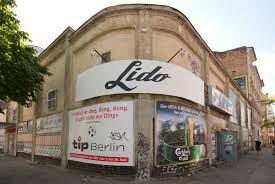
The size and sound were excellent with a good lighting rig and nice ambience. A large marquee has been erected beside the main room and this provided a chill out area with another bar and cloakroom. As we purchased our drinks, we were charged an extra euro as a deposit on each glass. We were given a token which could be redeemed when we wanted to leave. In between times, if wanting another drink, it was a matter of returning the glass to the bar rather than having to pay out another Euro deposit. This system worked really well and meant that the venue didn’t need glassies to pick up empties and there were then no glasses hanging around to become things which could get broken or become dangerous in a crowd system. People seemed to easily deal with doing this and the drink prices were very reasonable.
Cub Sport played a wonderful set with the singer Tim’s vocal soaring above the rest of the music on many occasions as they cranked out some very powerful melodic pop. Local Natives took over from where they had left off and also delivered a powerful set.
We headed home via the subway and S Bahn, meeting a young Russian guy from Moscow along the way who had flown to Berlin specifically to see Local Natives. He talked to us about the fact that public displays of affection amongst gay men were not seen in Moscow. He was aware of our recent changes to marriage laws in Australia and it was fascinating to spend some time talking to him as he tagged along with us as we were heading for the same destination at Alexanderplatz.
The next day, we set off to the East Side Gallery, a section of the former Berlin wall which is covered in some very poignant graffiti. This section of the wall ran along the East bank of the river, with the ‘death zone’ clear: that section between an outer and an inner wall where a person could be shot.
The Berlin wall had been erected suddenly by East Germany in 1961. For a range of reasons, including a drain of skilled and educated people from the east to the west via West Berlin, the wall was erected to stem this loss of resource to East Germany. It was also described, from the East, as a protective barrier against fascist forces. Huge numbers of militia were deployed to seal the border while construction teams erected the wall: 3.6 metres high, with a rounded pipe top and an inner wall constructed at a distance of about eighty or so metres. The area in between was an area in which guards would shoot to kill. The wall ran for around 160 kilometres right around West Berlin with only a limited number of designated road, river and rail corridors available to access West Berlin. These days, keen cyclists can complete the Mauerweg Trail, cycling the entire 160 km.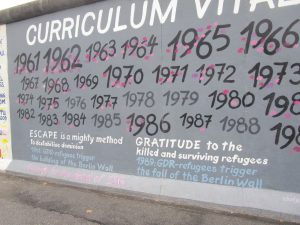
One very sad piece of graffiti mourned 136 people who had been killed trying to cross over.
The rain settled to a steady drizzle as we wandered along the wall wondering how it must have felt: to have suddenly been cut off from friends and family; to be able to see other Berliners across the wall yet be prevented from meeting with them in person.
As a young child not long into school, I can recall the stories on the news about the Berlin Wall, and the visit by President Kennedy to Berlin following incidents like the airlift which broke a Soviet blockade of West Germany. It was very surreal to be seeking these remnants of what was, for a young kid from Wongo Creek, a reality far away.
As the rain continued, we found a rooftop bar where we could get a coffee and look out across the river to the former West Berlin section. Talking to the barista, it turned out that he was born in 1990, so saw himself as the first of the new generations who were living without the divisions. 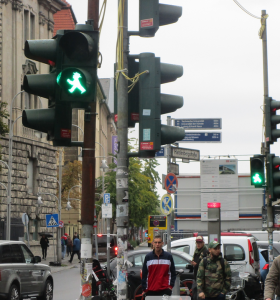 We mused about the hope for the future and yet there seems to be much left hanging in the consciousnesses within Berlin, where traffic lights have different icons for the green and red walk and stop man in the former East Berlin. The Ampelmannchen.
We mused about the hope for the future and yet there seems to be much left hanging in the consciousnesses within Berlin, where traffic lights have different icons for the green and red walk and stop man in the former East Berlin. The Ampelmannchen.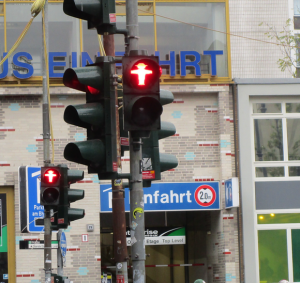
As we took in the amount of new buildings on this side of the river; part of the push for investment and building in the former East it is hard not to think about the fact that this was a place where so much must remain difficult for many people, yet their city provides a wonderful vibe and an energy different from many other cities.
In a message of some poignancy the sound system in the bar seemed to rise in volume a little as a Cat Stevens track came on. Recalling that I first heard this back in the very late sixties, or early seventies, it was possible to muse about the song itself:
Peace train sounding louder; everyone ride on the peace train…..
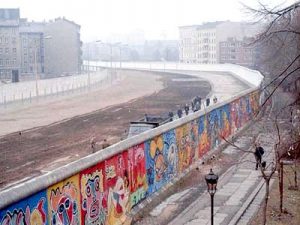 On Saturday, we walked up the Western side of the river and followed a curved section of road where a lovely green sunken garden followed what we found out later was a section of the Luisenstadt Canal which had been filled in back in the 1930s.
On Saturday, we walked up the Western side of the river and followed a curved section of road where a lovely green sunken garden followed what we found out later was a section of the Luisenstadt Canal which had been filled in back in the 1930s.
It had then; from 1961 to 1989 looked like this, as the wall and its death zone carved a scar through the former greenery and patrols and barriers prevented the crossing from one side to the other.
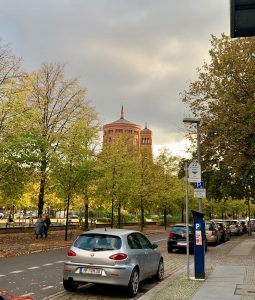 Today, as we start away from the river and follow the curve, coming up from the river toward the area where this stark first picture above was taken, it looks like this. The wall basically followed that line of trees…
Today, as we start away from the river and follow the curve, coming up from the river toward the area where this stark first picture above was taken, it looks like this. The wall basically followed that line of trees…
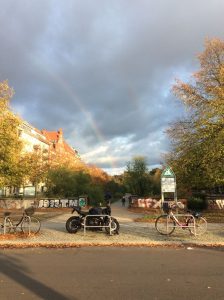
At Engelbecken Park, where the pond provides reflections and a passivity, as we paused to look back down the path of where this picture had been taken, a rainbow appeared above the zone of connection in what is now a green space again.
Despite the ongoing tensions between beliefs and groups evident today, we can only hope that the rainbow does indeed represent a vision of hope for the future.
We have walked far today yet remain glad that we have not had to walk in the shoes of those who have been torn between the lotteries of life existence.
Berlin: quirky, contrasts, vibrancy and much to reflect on. We’ll be back for more.
And; now: One of the random effects when importing posts from another blog. These pictures are from Nantes in France. One of our stops following our Paris to Epernay Bike and Barge trip in 2017.
no images were found
Thanks Roger, great piece. Berlin has changed much since I was there in 1981 when the wall was still up and it was quite dreary and depressing looking to the East side.
A great read. It felt like I was there, again. I was there in 1990 & our travel through East Berlin made us sad. Up until that time not a lot of money or love was spent.